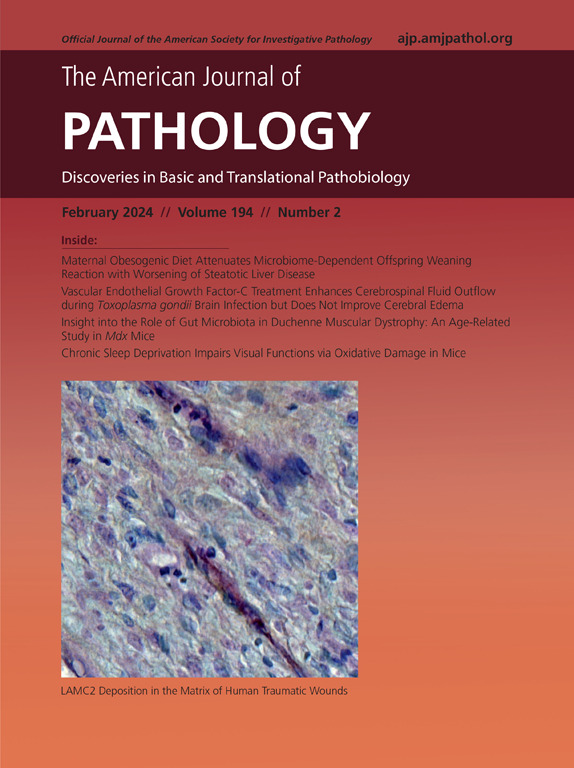Phosphatidylinositol 3-Kinase Signaling Enhances Intestinal Crypt Epithelial Cell Recovery after Radiation
IF 3.6
2区 医学
Q1 PATHOLOGY
引用次数: 0
Abstract
Intestinal stem cell (ISC) signaling maintains the balance of self-renewal and differentiation. Herein, the role of phosphatidylinositol 3-kinase (PI3K) signaling in ISC responses to radiation was interrogated using Villin-Cre pik3r1lox/lox (p85ΔIEC) mice and p85α-deficient human enteroids (shp85α). Lethal whole-body irradiation in mice was performed to monitor PI3K-mediated survival responses. Rectal biopsies from patients with radiation proctitis were examined by immunohistochemistry for the PI3K/Akt- and Wnt-target survivin. The intestinal epithelial cells (IECs) from p85ΔIEC mice showed increased protein levels of phosphorylated phosphatase and tensin homolog, phosphorylated AktSer473, survivin, cyclin D1, and ρ-β-cateninSer552, as well as increased mRNA for ISC/progenitor cell. In situ hybridization showed that enhanced PI3K signaling reduced leucine-rich repeat-containing G-protein coupled receptor 5 (Lgr5+) cells but enhanced AXIS inhibition protein 2 (Axin2+) cells. The shp85α enteroids showed increased mRNA expression of Wnt targets and transcription factor ASCL2, needed for dedifferentiation-mediated restoration of ablated ISCs. The p85α-deficient enteroids showed reduced HES1 mRNA and increases in secretory (ATOH1/MATH1) signaling determinants GFI1 and SPDEF, indicative of reduced NOTCH signaling. Seahorse analyses and phosphorylated p38 staining in IECΔp85 mice indicated that enhanced PI3K signaling led to increased IEC mitochondrial respiration and reactive oxygen species generation. Expression of survivin correlated with the radiation injury in patients. The current data indicate that PI3K signaling increased mitochondrial reactive oxygen species generation and ISC activation that improved IEC recovery from radiation-induced injury. The results suggest that increasing PI3K signaling and induced mitochondrial respiration may improve mucosal healing in patients with radiation injury.

磷脂酰肌醇3-激酶信号传导促进辐射后肠隐窝上皮细胞恢复。
肠干细胞(ISC)信号传导维持着自我更新和分化的平衡。利用Villin-Cre pik3r1lox/lox (p85ΔIEC)小鼠和p85α-缺陷人肠(shp85α)研究了磷脂酰肌醇3-激酶(PI3K)信号在ISC辐射应答中的作用。对小鼠进行致死性全身照射以监测pi3k介导的生存反应。采用免疫组化方法检测放射性直肠炎患者直肠活检中PI3K/Akt-和wnt -靶标存活蛋白。p85ΔIEC小鼠肠上皮细胞(IECs)磷酸化磷酸酶和紧张素同源物,磷酸化AktSer473、survivin、cyclin D1和ρ-β-cateninSer552蛋白水平升高,ISC/祖细胞mRNA水平升高。原位杂交显示,PI3K信号的增强减少了Lgr5+细胞,但Axin2+细胞的扩增。shp85α肠样细胞显示Wnt靶点和转录因子ASCL2的mRNA表达增加,这是消融的ISCs去分化介导的修复所必需的。p85α-缺陷肠样细胞HES1 mRNA减少,分泌(ATOH1/MATH1)信号决定因子GFI1和SPDEF增加,表明NOTCH信号减少。海马分析和IECΔp85小鼠磷酸化p38染色表明,PI3K信号的增强导致IEC线粒体呼吸和活性氧生成增加。survivin的表达与放射损伤相关。目前的数据表明,PI3K信号可以增加线粒体活性氧的产生和ISC的激活,从而改善辐射损伤后的IEC恢复。结果表明,增加PI3K信号和诱导线粒体呼吸可能会改善患者放射损伤后的粘膜愈合。
本文章由计算机程序翻译,如有差异,请以英文原文为准。
求助全文
约1分钟内获得全文
求助全文
来源期刊
CiteScore
11.40
自引率
0.00%
发文量
178
审稿时长
30 days
期刊介绍:
The American Journal of Pathology, official journal of the American Society for Investigative Pathology, published by Elsevier, Inc., seeks high-quality original research reports, reviews, and commentaries related to the molecular and cellular basis of disease. The editors will consider basic, translational, and clinical investigations that directly address mechanisms of pathogenesis or provide a foundation for future mechanistic inquiries. Examples of such foundational investigations include data mining, identification of biomarkers, molecular pathology, and discovery research. Foundational studies that incorporate deep learning and artificial intelligence are also welcome. High priority is given to studies of human disease and relevant experimental models using molecular, cellular, and organismal approaches.

 求助内容:
求助内容: 应助结果提醒方式:
应助结果提醒方式:


